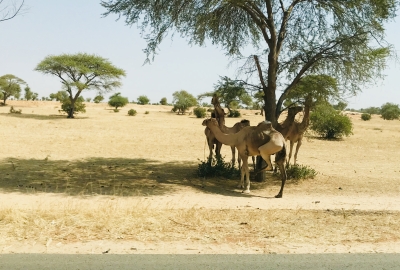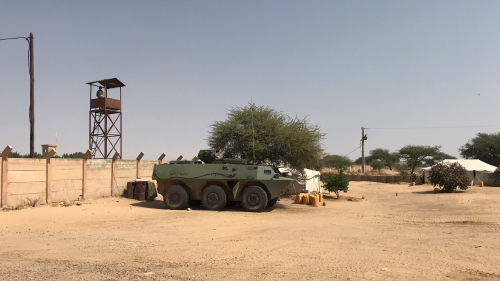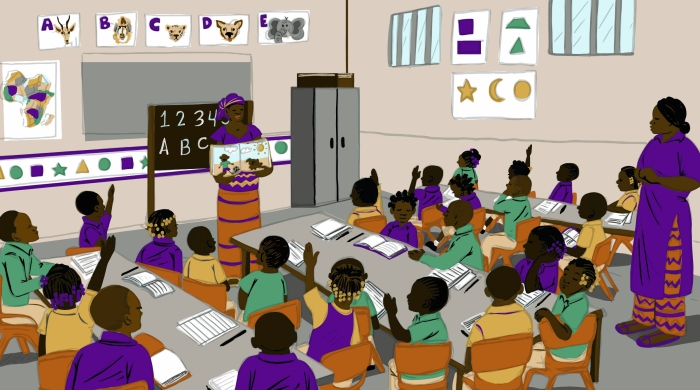
IHDSC met with NYU Global TIES for Children (TIES) researchers Lindsay Brown and Ha Yeon Kim to discuss their research with students in Niger and the insights and challenges that come with doing research in conflict-affected areas. This conversation was edited for clarity and length.
What motivated and inspired your research?
HA YEON KIM: The 3EA project in Niger came through as a collaboration between NYU-TIES and the International Rescue Committee (IRC). IRC has been really interested in evaluating their educational programs and building their social-emotional learning programs in humanitarian contexts. They have been working with refugee populations around the world for the past few decades and are now trying to build the evidence base for education in humanitarian and emergency settings. We got involved as a research partner for their projects in Lebanon, Niger, and Sierra Leone.
LINDSAY BROWN: This was an extension of an existing partnership between NYU-TIES and IRC in the Democratic Republic of Congo. NYU-TIES had done an evaluation of their curriculum and found that it did work to raise academic levels, although not enough to get kids up to grade level. There weren’t a lot of outcomes on students’ mental health either, which was another aim of the program. In addition to expanding the partnership and diversity of contexts, we were also hoping to improve upon the curriculum by testing a set of low cost-targeted and skill-targeted social-emotional learning activities in these contexts.
What makes Niger the best setting for your research?
KIM: It is one of the contexts and settings that needs the most support. We started to work in Niger because of the recent Boko Haram attacks on the border of Nigeria. There has been a huge increase in the refugee population in the border area. Historically and socio-politically, Niger is a very low resource country. It is among the lowest ranking countries by human development index in the world, with resource-scarce educational infrastructure especially in the Diffa region where we were, which is far from the capital city bordering Nigeria. And with the influx of refugees in the public school systems, their educational infrastructure was heavily challenged.
There are many humanitarian organizations working there, including IRC. One of the strengths IRC brings to education in emergency is a more comprehensive support. They’re supporting public schools by providing after school tutoring, some infrastructure like desks and books, and implementing social-emotional learning skills with the children who are the most vulnerable.
BROWN: In terms of thinking about education in conflict and crisis, Niger has all types of student populations that we would find. Because we were working in public schools, we were able to work with refugees who were fleeing Boko Haram in Nigeria, internally displaced students from within Niger, and host country kids who had always been there but were dealing with an influx of other kids into their schools. We were able to research how programming worked with different types of kids. Boko Haram also produces a unique type of conflict because, in addition to disrupting so many sectors of lives and livelihoods, it has a particular emphasis on disrupting education.
What are the challenges that come with conducting research in Niger, and how have you addressed these challenges?
BROWN: There are some challenges that are inherent in doing research in low-resource contexts that require a lot of planning and forethought as well as in-the-moment problem solving. Some of the things we take for granted, like having electricity or internet, are not a certainty in schools or even offices.
Because we are not from the area and because Boko Haram targets Western people who are working with organizations, especially in education, we had a lot of travel restrictions about whether or not we could go into the field at all. We wanted to be doing more in the field, but because of the safety issues, we were constrained with the amount of time we were allowed to spend there.
KIM: Because of the infrastructure challenges in Niger, it’s hard to build systematic tracking or obtain certain kinds of data. For example, schools don’t have lists of students who regularly attend. The administrative record was close to non-existent, so it was very difficult to identify the students we would be studying longitudinally.
Based on how you had to adapt to these challenges, what would you recommend to researchers who are looking to conduct research in similarly challenging settings?
KIM: I recommend working with local field staff or researchers, as well as local teachers and stakeholders such as mothers’ organizations (parents’ group) to get their perspective and an understanding of their infrastructure and context. There were also many things we didn’t expect until we went in to conduct research, in terms of research protocols and perception about certain wordings used in the program (e.g., the initial title of the Mindfulness program we implemented was the same as the name of a local Christian radio channel), so I definitely would recommend a pilot study with enough time built in to contextualize and really adapt to what it takes to do research in that setting.
BROWN: If you can, build in a bigger budget for data staff than you think you’ll need at the outset, because things can get out of hand quickly. If possible, find some sort of cultural liaison who knows the culture you're working within. We ended up working with someone who was initially assigned to us as a translator. She grew up in Niger but had traveled abroad to many places and could help anticipate cultural or contextual misunderstandings as well as clarify them as they were happening.
What are some surprising or interesting findings from your research so far?
KIM: We’ve conducted multiple randomized controlled trials in Niger but also Lebanon and Sierra Leone. In some cases, there were programs that had no impact, especially for social-emotional learning programs. In a rigorous hypothesis testing framework, after statistically adjusting for all the methodological limitations, we did not always find the intended positive impact on some of the outcomes where we really wanted to see an impact. It’s really challenging to think about what this means, when we don’t even fully understand how these cognitive and social-emotional skills we want to improve operate in the lives kids are living in this context. We’re still trying to puzzle that out, but the collaboration with IRC has been really helpful to think through questions of next steps.

BROWN: One thing that we found in the first year of the program was that students who had additional social-emotional learning activities received higher grades from their teachers than students who were in the tutoring program without the social-emotional learning activities. We’ve seen conflicting findings in each context about what the social-emotional learning activities might be doing, but this finding fits the theory that students may acquire skills that would be picked up by teachers in the classroom and incorporated into grades, like increased effort, before those students would score higher on achievement tests.
What impact are you hoping will come from this research?
BROWN: The ultimate goal is that we’re able to improve academic and wellbeing outcomes of students in crisis in conflict. This is such a vulnerable population, and school can provide a place where students feel a sense of safety. They can feel supported. They can generate a caring relationship with an adult, which can buffer against all sorts of long-term consequences of trauma. It has positive downstream effects in terms of decreasing child marriage and increasing other health outcomes. I think if we can improve access to schooling and improve the quality of schooling, that is the long-term goal.
KIM: One in five children in the world are growing up in conflict affected areas. It’s a huge population of kids. If you’re not educating them, you’re not supporting them. If the research and evidence we’re producing can advocate for and help improve their quality of and access to education, that would be the biggest impact we could have.
Photo credits: Ha Yeon Kim
Learn More
Global TIES for Children
Global TIES for Children is an international research center at New York University dedicated to designing, evaluating and advising on programs and policies to improve the lives of children and youth in the most vulnerable regions across the globe.


